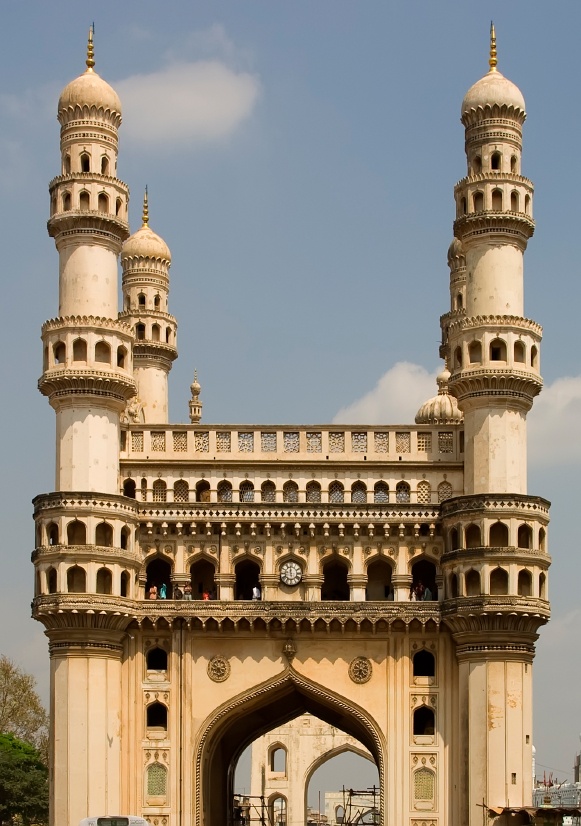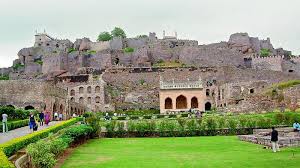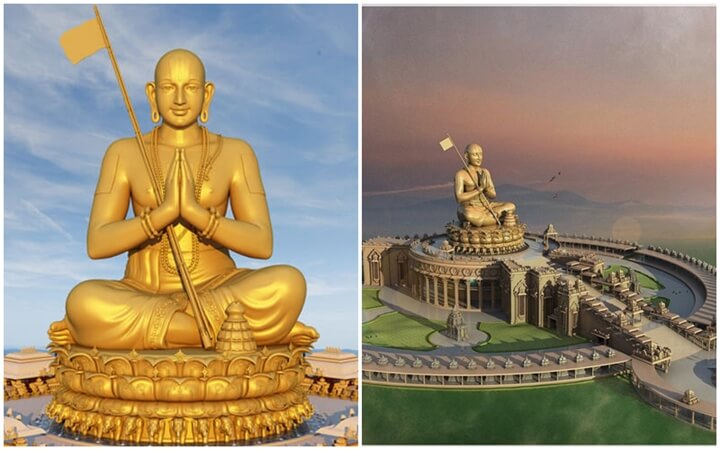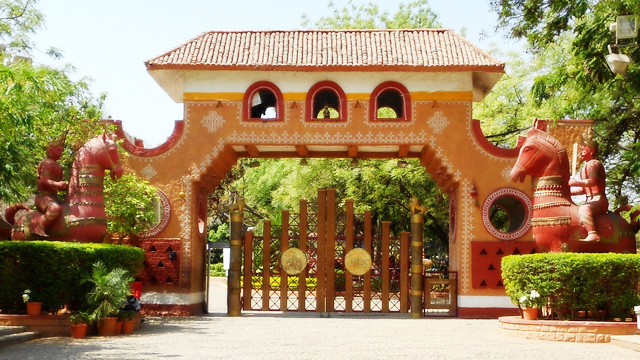
CHARMINAR
Undeniably the most prominent landmark of Hyderabad, Charminar has rightly been called as ‘Arc de Triomphe of the East’. It is also called the ‘Mosque of the four minarets’. Not visiting this magnificent architecture while on a Hyderabad tour is nothing less than a sacrilege, especially if you are a travel enthusiast. Not only Hyderabad, Charminar has become an iconic monument for the entire India. An Urdu word, Charminar, means four turrets (char- four, minar-turret). Charminar was built by Sultan Mohammed Quli Qutb Shah in 1591. It is said that this square shaped structure with four pillars and intricate carvings was built in honour of his wife, Bhagmati.

Golconda Fort
Golconda Fort is located in the western part of Hyderabad city and is about 9 km from the Hussain Sagar Lake. It was originally known as Mankal, and built on a hilltop in the year 1143. It was originally a mud fort under the reign of Rajah of Warangal. Later it was fortified between 14th and 17th centuries by the Bahmani Sultans and then the ruling Qutub Shahi dynasty. Golconda was the principal capital of the Qutub Shahi kings. Golconda fort is undoubtedly one of most magnificent fortress complexes in India. The history of Golconda Fort goes back to early 13th century, when it was ruled by the Kakatiya’s followed by Qutub Shahi kings, who ruled the region in 16th and 17th century. The fortress rests on a granite hill 120 meters high while huge crenellated ramparts surround this structure.

Birla Mandir
The architectural style of the Birla temple is a blend of North Indian and South Indian styles of temple architecture. The temple tower or the ‘Gopuram’ exhibits the salient features of South Indian temples. The Jagadananda Vimanam built atop the sanctum sanctorum resembles the Oriya style of temple architecture. It took 10 years of dedication and hard work of sculptors and artisans to complete the construction of this temple. The flagstaff of the Birla Mandir which has a height of 42 feet is made of brass. Scenes from the epics of Ramayana and Mahabharata are intricately carved on the walls and ceilings of the temple. The statues of deities belonging to Hindu mythology can be found from the entrance up to the sanctum sanctorum of the temple.

Chowmahalla Palace
Chowmahalla Palace, with the literal meaning of ‘four palaces’ in Urdu language was built in the 18th century. It was during the reign of the fifth Nizam, Afzar-ud-Daulah, Asaf Jav V, from 1857 to 1869, that the palace was completed. Initially spread across an area of 45 acres, the palace now covers 12 acres of land. It has been open for public viewing since 2005 and is ranked among the top forts and palaces in Hyderabad. There is a minimal fee for entering the palace. It is open from 10 am to 5 pm every day except on Fridays and on national holidays.

Ramoji Film City
Since 1991, Ramoji Film City has been attracting tourists from every corner of the country. One of the largest film studios in the world, it has the capacity to house almost 50 film units within a given point of time. It is also listed in the Guinness Book of World Records as well. It tops the list of most amazing things to do in Hyderabad. Spread over 2500 acres, it is situated about 30 km away from Hyderabad city center. Its brilliant architecture and sound technical facilities make it suitable for all the pre and post-production of a film.

Tank Bund
Tank Bund has a rich history that dates back to the reign of the Qutb Shahi dynasty in the 16th century. The bund (embankment) was built to prevent the flooding of the city and provide a source of water for irrigation. It was during the rule of Ibrahim Quli Qutb Shah, the fourth ruler of the Qutb Shahi dynasty, that the construction of the bund commenced. Over the years, various renovations and enhancements transformed it into the captivating attraction it is today. Tank Bund, the architectural marvel in Hyderabad, was designed and constructed under the supervision of Sir Mokshagundam Visvesvaraya, a renowned engineer and statesman of India. The construction of Tank Bund began in 1923 and was completed in 1930, making it an impressive engineering feat of its time.

Statue of Equality
The Statue of Equality, located in Hyderabad, India, is a monumental statue of Saint Ramanujacharya, a revered 11th-century Vaishnavite philosopher and social reformer. Standing at 216 feet, it is one of the tallest seated statues in the world. Inaugurated in 2022, it symbolizes equality, compassion, and social justice, reflecting Ramanuja’s teachings of universal brotherhood and inclusivity. The statue complex also features a golden statue, meditation hall, and educational facilities.

Shilparamam
Shilparamam Arts and Crafts village is a tribute to the cultural legacy of India. The primary aim of this establishment is to foster, restore and help flourish the culture of India’s glorious past. It provides a common platform for artisans and performing artists to showcase their talents. Nestling amidst rocks, rippling waterfalls and gorgeous lawns, Shilparamam is a melting pot of traditions and cultures. Here each season brings a mood of festivity and Indian festivals are celebrated in the most traditional way. Shilparamam hosts a multitude of ethnic art, crafts and culture from all over the country.

